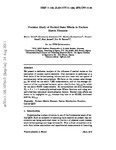Precision study of excited state effects in nucleon matrix elements
| dc.contributor.author | Dinter, S | |
| dc.contributor.author | Alexandrou, C | |
| dc.contributor.author | Constantinou, M | |
| dc.contributor.author | Drach, V | |
| dc.contributor.author | Jansen, K | |
| dc.contributor.author | Renner, DB | |
| dc.date.accessioned | 2018-07-25T15:38:42Z | |
| dc.date.available | 2018-07-25T15:38:42Z | |
| dc.date.issued | 2011-10 | |
| dc.identifier.issn | 0370-2693 | |
| dc.identifier.issn | 1873-2445 | |
| dc.identifier.uri | http://hdl.handle.net/10026.1/11917 | |
| dc.description | 14 pages, 4 figures | |
| dc.description.abstract |
We present a dedicated analysis of the influence of excited states on the calculation of nucleon matrix elements. This calculation is performed at a fixed value of the lattice spacing, volume and pion mass that are typical of contemporary lattice computations. We focus on the nucleon axial charge, gA, for which we use about 7500 measurements, and on the average momentum of the unpolarized isovector parton distribution, 〈x〉u-d, for which we use about 23,000 measurements. All computations are done employing Nf=2+1+1 maximally-twisted-mass Wilson fermions and using non-perturbatively calculated renormalization factors. Excited state effects are shown to be negligible for gA, whereas they lead to an O(10%) downward shift for 〈x〉u-d. © 2011 Elsevier B.V. | |
| dc.format.extent | 89-93 | |
| dc.language | en | |
| dc.language.iso | en | |
| dc.publisher | Elsevier BV | |
| dc.subject | Nucleon matrix element | |
| dc.subject | Parton distribution function | |
| dc.subject | Lattice QCD | |
| dc.title | Precision study of excited state effects in nucleon matrix elements | |
| dc.type | journal-article | |
| dc.type | Journal Article | |
| plymouth.author-url | https://www.webofscience.com/api/gateway?GWVersion=2&SrcApp=PARTNER_APP&SrcAuth=LinksAMR&KeyUT=WOS:000295750500016&DestLinkType=FullRecord&DestApp=ALL_WOS&UsrCustomerID=11bb513d99f797142bcfeffcc58ea008 | |
| plymouth.issue | 1-2 | |
| plymouth.volume | 704 | |
| plymouth.publisher-url | http://dx.doi.org/10.1016/j.physletb.2011.09.002 | |
| plymouth.publication-status | Published | |
| plymouth.journal | Physics Letters B | |
| dc.identifier.doi | 10.1016/j.physletb.2011.09.002 | |
| plymouth.organisational-group | /Plymouth | |
| plymouth.organisational-group | /Plymouth/Faculty of Science and Engineering | |
| plymouth.organisational-group | /Plymouth/Faculty of Science and Engineering/School of Engineering, Computing and Mathematics | |
| plymouth.organisational-group | /Plymouth/REF 2021 Researchers by UoA | |
| plymouth.organisational-group | /Plymouth/REF 2021 Researchers by UoA/EXTENDED UoA 10 - Mathematical Sciences | |
| plymouth.organisational-group | /Plymouth/REF 2021 Researchers by UoA/UoA10 Mathematical Sciences | |
| plymouth.organisational-group | /Plymouth/Users by role | |
| plymouth.organisational-group | /Plymouth/Users by role/Academics | |
| dc.identifier.eissn | 1873-2445 | |
| dc.rights.embargoperiod | No embargo | |
| rioxxterms.versionofrecord | 10.1016/j.physletb.2011.09.002 | |
| rioxxterms.licenseref.uri | http://www.rioxx.net/licenses/all-rights-reserved | |
| rioxxterms.type | Journal Article/Review |


